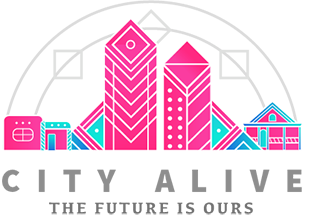Four Years in Review – A Hard Look at the Data
As we near the close of 2017 and our fourth year as a Living Cities Integration Initiative, we sat down to analyze how are we doing around these long-term goals. Here are the results:
City Alive is focused on accelerating job creation and economic mobility through innovation and entrepreneurship with long-term goals of:
- Adding 10,000 net new jobs by 2025
- Reducing unemployment to 4.5% by 2025
- Increasing median weekly wages to $932 by 2025 with a focus on racial and income equity.
We chose these goals because they indicate strong progress toward a more inclusive, diverse and healthy economy and future.
Our Progress Report
Our progress data, updated monthly with jobs and economic data collected through the census and updated by the City of Albuquerque, provides insight into our progress toward long-term goals.
Here is where we stand:
In 2017, the first two quarters were the strongest for number of new business registrations in Albuquerque since 2012, with more than 1,400 registrations each quarter, and we’ve seen the average weekly wage and job market grow considerably.
Goal 1: Add 10,000 net new jobs by 2025
Albuquerque has seen 48 months of consecutive job growth. In January of 2014, Albuquerque had 371,100 jobs. As of October, 2017 we have 396,200, a 6.8% percent increase in jobs over that time period. This goal is currently being refined to more thoroughly track City Alive’s direct impact on job creation. See this article to meet the Harvard graduate students conducting a key survey that will contribute to benchmarking our results.
Goal 2: Reduce unemployment to 4.5%
The unemployment rate in Bernalillo County in January of 2014 was 6.5%. In October, 2017, that rate had fallen to 5.4%. We are on track toward our goal of reducing unemployment to 4.5% by 2024.
Goal 3. Increase median weekly wages to $932
In December of 2013, the median weekly wage in Albuquerque was $837. As of March, 2017, wages were up to $896. We are over 60 percent of the way toward our goal of increasing the median weekly wage to $932.
Taking a Harder Look
We are so thrilled by these successes. But there is a story behind that story.
It’s easy to see only what we want to see. But it’s not enough to simply focus on new business growth, and believe the systemic inequities will unravel themselves. The reality of Albuquerque’s economic conditions is broad, deeply rooted and critical. We have to look at the larger, more challenging picture.
Albuquerque’s rich history celebrates our cultural diversity, yet this distinctive tapestry also tells the story of families fighting agonizing disparity. The population City Alive is focused on supporting are low-income people (who represent 70 percent of our population). Albuquerque suffers in three major sectors:
Systemic poverty:
- 25% of children and 18% of the general population live in poverty
- 32% of parents lack secure employment (AECF, 2012)
- Nine of Albuquerque’s 17 zip codes have a poverty rate greater than the national average, with some approaching 2.5 times that rate.
Job growth:
- Albuquerque recently ranked last out of 200 cities surveyed by Forbes for job growth
- 44 percent of New Mexico households are “liquid asset poor,” which means that if faced with an emergency, they lack adequate savings to cover basic expenses for three months. (Prosperity Now 2016)
- Albuquerque ranks lowest in micro-business support, minimum wage, paid leave, unemployment benefits, unemployed entrepreneur support and workforce development/sector partnerships
Poor education:
- Ranked 39th for number of adults with a four year college degree
- Ranked 50th for disparities in college degree attainment by race (2.6 times higher for white adults than populations of color, compared to 1.6 times nationally)
- Ranked 49th in 8th grade reading proficiency and 47th in 8th grade math proficiency (Prosperity Now 2016)
So…what are we doing about all this?
Our performance data indicates that unemployment is dropping and average monthly earnings are rising across all racial and ethnic groups, however, gaps persist that continue to remind us of the importance of an unwavering commitment to inclusive economic development. This commitment means that we are creating and supporting programs, changing systems and fostering opportunities that not only open the door to those who have historically been marginalized, but that they are actually walking in the door.
Learn more about some of the programs City Alive and our leadership partners support that are focused on equitable economic development:
- Co-Op Capital – Accessible capital for entrepreneurs with low or no credit
- The Mayor’s Prize for Entrepreneurship – Grants for entrepreneurial support organizations
- Emprendedores – Spanish language program for the entrepreneurial mindset at the Albuquerque Hispano Chamber of Commerce
- 2+1+2 – UNM and CNM’s fast track path to a graduate degree that might otherwise be unattainable
How to Forge Ahead
In this line of work we need focus, we need benchmarking, we need data. But, most importantly, we need collaboration to reach our shared goal. Our city can only change course if we partner and work together with aligned vision and contributions.
The data here in Albuquerque can paint a bleak picture, one that we keep top-of-mind to motivate our work without annihilating our optimism. If we are interested in building mass movements to change systems, it’s time to act collectively. I believe those interested in advancing diversity, equity and inclusion have an obligation to sit at leadership tables like City Alive. The bigger the table, the better the possibilities.
We’re at a critical moment in the history of our city. We’re disrupting the systems that have held down our most vulnerable citizens. We’re looking through the lens of equity in everything we do. We’re creating a new model for prosperity.
These are exciting times with much at risk. But the risk isn’t stepping out into the unknown. The risk is missing the opportunity to do so.



